#arduino programming
Explore tagged Tumblr posts
Text
Unlock the Future with Robotics: Join the Best Robotics Classes in Mumbai!
In today's fast-paced world, technology and innovation drive the future, and robotics is at the forefront of this revolution. Whether you're a school student, a young learner, or someone curious about robotics, learning this dynamic field can unlock endless possibilities. If you want to get started, Technobotics Robotics Classes in Mumbai is the place to be. Let's dive into why these classes are perfect for your child's bright future!
Why Choose Robotics Classes for Kids in Mumbai?
Incorporating robotics into a child's education is no longer just an option but a necessity. Robotics for school students helps develop problem-solving skills, fosters creativity, and encourages teamwork—all of which are essential in today's competitive world. Technobotics offers hands-on learning experiences that engage young minds and prepare them for careers in fields like engineering, technology, and artificial intelligence (AI).

What Makes Technobotics Unique?
Technobotics, a leading techno school for robotics, offers a range of robotics courses for kids that go beyond the basic knowledge of coding and circuits. Here are some reasons why Technobotics Robotics Classes stand out:
Tailored Programs for All Levels: Whether your child is a complete beginner or already familiar with the basics of robotics, Technobotics offers classes that cater to different age groups and skill levels. From basic robotic kits to advanced autonomous robotics courses, your child will progress at a pace that suits them.
Hands-on Learning: Children not only learn theories; they also create robots! The curriculum is designed to improve creativity and practical skills. Students work on exciting projects, learning everything from Arduino programming to autonomous robotics. Students work on exciting projects, learning everything from Arduino programming to autonomous robotics.
Future-Focused Skills: Robotics involves a blend of Science, Technology, Engineering, and Mathematics (STEM), making it the ideal foundation for future careers. At Technobotics, students develop coding, problem-solving, teamwork, and innovation skills—traits that will set them apart in the tech world.
Safe and Interactive Learning Environment: The courses are designed to be enjoyable, engaging, and informative, allowing kids to explore their curiosity within a safe learning environment.
What Will Your Child Learn at Technobotics?
Technobotics offers a variety of robotics courses designed for different interests and expertise levels:
Autonomous Robotics (With & Without Programming): These courses teach students how to create robots that can operate independently without constant human control. Programming skills are also covered to enhance robot functionality.
Arduino Programming for Beginners: A beginner-friendly course that introduces kids to the programming world with Arduino, empowering them to create interactive robotics projects.
Breadboard Electronics: This course covers the essential electronics concepts needed to build functional robots.
With these well-rounded courses, your child will be on their way to mastering robotics and shaping a bright future in technology.
Why Robotics is the Future for Your Child
In an era where AI, robotics, and automation are transforming industries, kids must start learning about these technologies early on. Enrolling in Technobotics robotics classes for school students will give your child a competitive edge in their academic and professional pursuits. The skills learned will be invaluable in robotics, engineering, software development, and beyond.
Conclusion: Start Your Child's Robotics Journey Today!
If you want to give your child the best foundation in robotics, Technobotics Robotics Classes in Mumbai is your answer. With a focus on hands-on learning, innovative thinking, and a passion for technology, Technobotics is more than just a school—it's a launchpad for your child's future in robotics. Visit Technobotics Robotics Classes today to learn more and enrol your child in Mumbai's most exciting learning experience.
#robotics for kids#robotics classes#STEMEducation#robotics in mumbai#arduino programming#robotics courses#breadboard electronics for beginners
0 notes
Text

0 notes
Text
youtube
Arduino programming tutorial: How to use #wokwi web-based Arduino simulator with UNO as an Arduino board for 4 Way 4 Phase with DUAL cd74hc595 Shift Register Arduino Traffic Lights Signal #intersection Project based learning examples step by step how to code arduino with scratch for #beginners
#programming#traffic light#how to#tutorials#arduino#simulator#Shift Register#cd74hc595#DUAL cd74hc595#Arduino programming#wokwi#Arduino simulator#Youtube
0 notes
Text
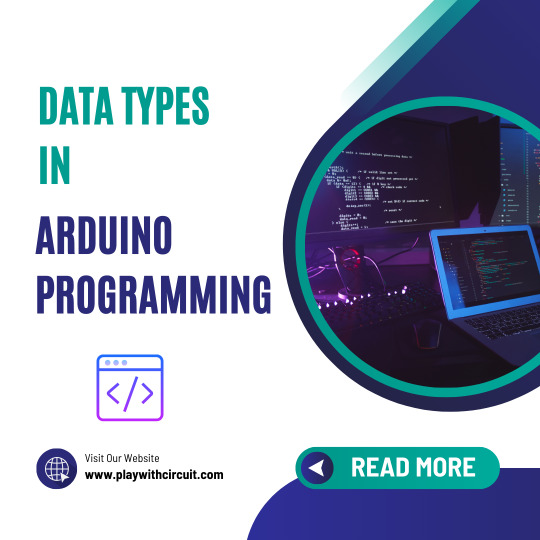
Data Types in Arduino programming
In Arduino programming, data types are used to define the type of data that a variable can hold. The data types are essential for declaring variables in Arduino sketches, helping to optimize memory usage and ensure that the variables can hold the appropriate values for a given application. Checkout this article to learn more.
0 notes
Text
I made an output agnostic logging framework for embedded devices that would work on anything as it's written only with standard C++ libs. In theory I could use it for linux or pis, lol. I made it because I kept having to write new handlers for serial, mqtt, uart, then having to like wire them all together without creating dependency loops or other issues - especially because I often work on meshes or online embedded devices that require multiple outputs. Now you just write your handler, tell it what tags to watch, and it'll log according to tag and log level. So you could write a serial debugging log handler when you're first making it. Then when you're done, disable it, and it'll stop outputting - but then later assign the serial debugging log tag to your MQTT handler and get all your debugging serial lines output to MQTT - then just disable it again when you're done. There's still some polish I need to put into it, it has some jank, some bugs, but it's working and neat. it's kind of neat.
39 notes
·
View notes
Text
iFixit + Adafruit - Hack, mod, and explore the Nintendo Alarmo ⏰🔧
Thanks, iFixit, for an awesome teardown — what a way to celebrate Mario Day! Now that we’ve seen what makes the Alarmo tick, let’s take it to the next level. It's a me! Ladyada from Adafruit, and we’re about to hack this clock and see what we can make it do. Power up, because here comes the fun!
youtube
#MarioDay#ifixit#adafruit#nintendo#alarmo#marioday#hack#modding#teardown#electronics#retrogaming#maker#hardwarehacking#gaminggear#diyprojects#techmods#gamingtech#gamingcommunity#arduino#raspberrypi#openhardware#programming#linux#python#java#software engineering#custombuild#geeklife#gaminghacks#techenthusiast
16 notes
·
View notes
Text
Desperately trying to find the tech AV/robotics/coding community of tumblr.
WHERE ARE YOU. PLEASE. GIVE ME LIFE. HEAR MY HASHTAGS AND FIND ME.
#tech crew#tech#audiovisual#theatre#backstage#backstage drama#lighting#robotics#coding#programming#developers#engineering#rusty the steam engine#c++#c++ programming#python#arduino#computing
10 notes
·
View notes
Text
Just finished making a circuit diagram in Fritzing and I don’t know if I’m doing it wrong or something because it was pretty annoying to put together.
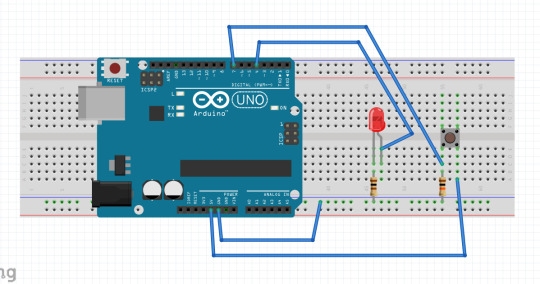
This is the diagram that I made, really simple yet it took me a while. It wasn’t hard to find the parts that I wanted to add, but the controls for moving them around were simply annoying to use. Not to mention the weird zoom in/out controls. For some reason I couldn’t use the touchpad to zoom out? Only zoom in? Idk, I’ll make another post if it gets better with use.
If you want to see my circuits homework for whatever reason, it’s under the cut.
Here’s a video of the circuit in question working in real life. The goal is to make the light turn off for two seconds only after the button is released. LED is in series with a 100 ohm resistor just to make sure it doesn’t burn out (and to make it a little less painful on the eyes). Button is wired in a pulldown resistor setup (the detector is after the button) with a 10k resistor. This is so that when the button is pressed, the value reads as high.
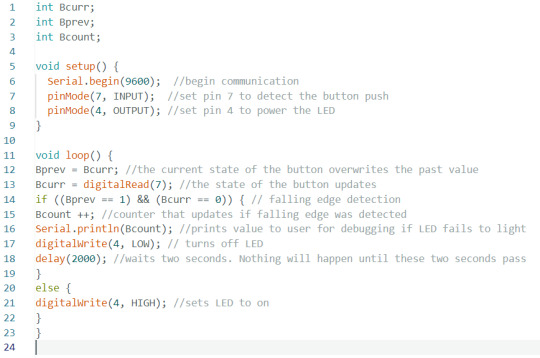
This is the C++ code that is running on the Arduino uno. It just uses an If else statement to control the state of the LED according to the button. Read the comments (grey text) for a short explanation of what each line does. If you want a more in depth explanation uhh message me I guess.
#pretty simple circuit but it touches on a lot of topics#idk it's simple to me#stemblr#arduino#electrical wiring#c++#c++ programming#fritzing#circuit diagram#unironically my homework#the documentation takes more time than anything else :/
9 notes
·
View notes
Text
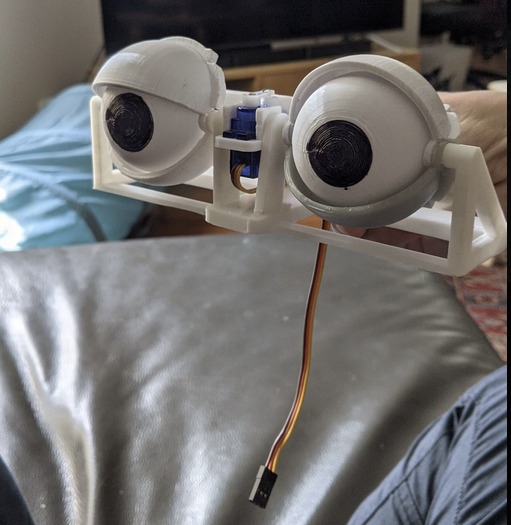
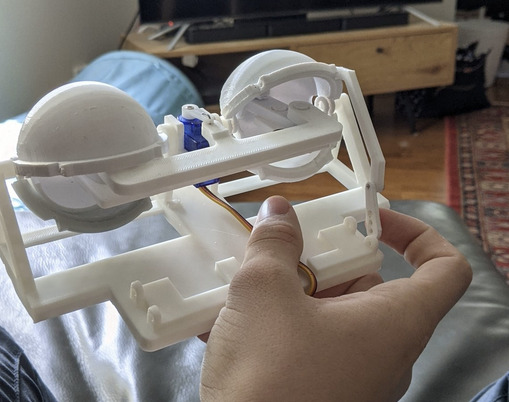
now we get into the time where i focused more on animatronics. this was a very rough first pass of my v1 eye mech, inspired heavily by will cogley's simply eye mech. actually like 90% of these parts were used in the final version which is kinda sad
6 notes
·
View notes
Text

This is the first set up for the smart meter (the physical build that is). I copied down some basic code to make it work and removed the screen until I know I can make it work. While the code is running well and the sensor seems to be working (it responded to when I open and close it), I still have yet to read the AC current of cords successfully.
I tried reading the current going through my lava lamp and a few other cords in my room without success, but I’m still optimistic about it working. I just need to re-review the code and make sure I choose actual AC devices to test it on.
6 notes
·
View notes
Text

:3
#i stay perfectly on task all the time#evee posts#programming#uhh idek what i tag these anymore#arduino#?
7 notes
·
View notes
Text
Capstone #11: Final?
<-<- FIRST || <- PREV || NEXT ->
First off, Capstone is done done and just waiting on graduation. Next up, our capstone won us a little award! We did our little poster session and showed off the assembly. But lets show off something I wish I had done under the cut
The Arduino doesn't have the ability to process more than one thing at a time, it doesn't even have threads. It's single core, single thread. So when the gantry wants to move, it needs to do all the math of where to go, then move the stepper motors. The entire time where it's calculating, the motors aren't moving, and the entire time the motors are moving, the cpu is sitting there doing jackshit nothing. And it has to do this for each and every stepper step until it reaches the end position. (The speed of this is dramatically slowed. The actual stepper step takes about 3 milliseconds, and the calculation takes maybe a few clock cycles (idk exactly how long, but lets just say ~0.005 milliseconds)). Point is, 3 milliseconds is an eternity to a cpu.
In that 3 milliseconds we could do a lot of things. Lets use time more efficiently...
In the project I had coded the gantry to not use a queue and event handler. This is mostly because of a lack of hindsight. But had I, it would something like this: The "math" process does the math and drops the result into the queue, the "gantry" process picks up the next thing in the queue and executes it. In the meantime while the cpu is waiting for the motor to reach its position, there's plenty of time to do plenty more math and start filling the queue. Because math is fun and it can't wait to do MORE math (:
All this makes this run far faster by doing 2 things at once. It gives you more control over how fast the gantry moves, because its speed depends on how fast you read from the queue. Once the queue is filled you could even spend that time doing literally anything else, like blinking lights, updating screens, or read from sensors.
There ARE even more clever things you can do, but this is just one that I feel like I totally could have done if I wasn't already nearly done by the time I thought of it
2 notes
·
View notes
Text
SOMEONE GIVE ME A BLOODY INTERNSHIP 😭
#upcoming electronics engineer#proficient in embedded system in c. c++. c. python. and dsa in c++. and programming micro controllers like arduino uno and stm32.#PLEASE HIRE ME PAID OR NOT.
2 notes
·
View notes
Text
My worker firmware works! It flashed itself over, now just to add some roll back, security, and validation features. But effectively this means I never have to plug in another ESP32 to send them firmware. I can just tell them to post to MQTT from the worker firmware for logging and post the firmware binary to my local file server. This makes my life so much easier while building out this mesh of meshes multi-protocol com lib. Hell yeahhh
#trans#queer#transgender#tech#esp32#maker#computer#programming#c++#arduino#embedded software#firmware
7 notes
·
View notes
Text
iFixit + Adafruit - Hack, mod, and explore the Nintendo Alarmo ⏰🔧
Thanks, iFixit, for an awesome teardown — what a way to celebrate Mario Day! Now that we’ve seen what makes the Alarmo tick, let’s take it to the next level. It's a me! Ladyada from Adafruit, and we’re about to hack this clock and see what we can make it do. Power up, because here comes the fun!
youtube
#MarioDay#ifixit#adafruit#nintendo#alarmo#marioday#hack#modding#teardown#electronics#retrogaming#maker#hardwarehacking#gaminggear#diyprojects#techmods#gamingtech#gamingcommunity#arduino#raspberrypi#openhardware#programming#linux#python#java#software engineering#custombuild#geeklife#gaminghacks#techenthusiast
14 notes
·
View notes
Text
Mastering Neural Networks: A Deep Dive into Combining Technologies
How Can Two Trained Neural Networks Be Combined?
Introduction
In the ever-evolving world of artificial intelligence (AI), neural networks have emerged as a cornerstone technology, driving advancements across various fields. But have you ever wondered how combining two trained neural networks can enhance their performance and capabilities? Let’s dive deep into the fascinating world of neural networks and explore how combining them can open new horizons in AI.
Basics of Neural Networks
What is a Neural Network?
Neural networks, inspired by the human brain, consist of interconnected nodes or "neurons" that work together to process and analyze data. These networks can identify patterns, recognize images, understand speech, and even generate human-like text. Think of them as a complex web of connections where each neuron contributes to the overall decision-making process.
How Neural Networks Work
Neural networks function by receiving inputs, processing them through hidden layers, and producing outputs. They learn from data by adjusting the weights of connections between neurons, thus improving their ability to predict or classify new data. Imagine a neural network as a black box that continuously refines its understanding based on the information it processes.
Types of Neural Networks
From simple feedforward networks to complex convolutional and recurrent networks, neural networks come in various forms, each designed for specific tasks. Feedforward networks are great for straightforward tasks, while convolutional neural networks (CNNs) excel in image recognition, and recurrent neural networks (RNNs) are ideal for sequential data like text or speech.
Why Combine Neural Networks?
Advantages of Combining Neural Networks
Combining neural networks can significantly enhance their performance, accuracy, and generalization capabilities. By leveraging the strengths of different networks, we can create a more robust and versatile model. Think of it as assembling a team where each member brings unique skills to tackle complex problems.
Applications in Real-World Scenarios
In real-world applications, combining neural networks can lead to breakthroughs in fields like healthcare, finance, and autonomous systems. For example, in medical diagnostics, combining networks can improve the accuracy of disease detection, while in finance, it can enhance the prediction of stock market trends.
Methods of Combining Neural Networks
Ensemble Learning
Ensemble learning involves training multiple neural networks and combining their predictions to improve accuracy. This approach reduces the risk of overfitting and enhances the model's generalization capabilities.
Bagging
Bagging, or Bootstrap Aggregating, trains multiple versions of a model on different subsets of the data and combines their predictions. This method is simple yet effective in reducing variance and improving model stability.
Boosting
Boosting focuses on training sequential models, where each model attempts to correct the errors of its predecessor. This iterative process leads to a powerful combined model that performs well even on difficult tasks.
Stacking
Stacking involves training multiple models and using a "meta-learner" to combine their outputs. This technique leverages the strengths of different models, resulting in superior overall performance.
Transfer Learning
Transfer learning is a method where a pre-trained neural network is fine-tuned on a new task. This approach is particularly useful when data is scarce, allowing us to leverage the knowledge acquired from previous tasks.
Concept of Transfer Learning
In transfer learning, a model trained on a large dataset is adapted to a smaller, related task. For instance, a model trained on millions of images can be fine-tuned to recognize specific objects in a new dataset.
How to Implement Transfer Learning
To implement transfer learning, we start with a pretrained model, freeze some layers to retain their knowledge, and fine-tune the remaining layers on the new task. This method saves time and computational resources while achieving impressive results.
Advantages of Transfer Learning
Transfer learning enables quicker training times and improved performance, especially when dealing with limited data. It’s like standing on the shoulders of giants, leveraging the vast knowledge accumulated from previous tasks.
Neural Network Fusion
Neural network fusion involves merging multiple networks into a single, unified model. This method combines the strengths of different architectures to create a more powerful and versatile network.
Definition of Neural Network Fusion
Neural network fusion integrates different networks at various stages, such as combining their outputs or merging their internal layers. This approach can enhance the model's ability to handle diverse tasks and data types.
Types of Neural Network Fusion
There are several types of neural network fusion, including early fusion, where networks are combined at the input level, and late fusion, where their outputs are merged. Each type has its own advantages depending on the task at hand.
Implementing Fusion Techniques
To implement neural network fusion, we can combine the outputs of different networks using techniques like averaging, weighted voting, or more sophisticated methods like learning a fusion model. The choice of technique depends on the specific requirements of the task.
Cascade Network
Cascade networks involve feeding the output of one neural network as input to another. This approach creates a layered structure where each network focuses on different aspects of the task.
What is a Cascade Network?
A cascade network is a hierarchical structure where multiple networks are connected in series. Each network refines the outputs of the previous one, leading to progressively better performance.
Advantages and Applications of Cascade Networks
Cascade networks are particularly useful in complex tasks where different stages of processing are required. For example, in image processing, a cascade network can progressively enhance image quality, leading to more accurate recognition.
Practical Examples
Image Recognition
In image recognition, combining CNNs with ensemble methods can improve accuracy and robustness. For instance, a network trained on general image data can be combined with a network fine-tuned for specific object recognition, leading to superior performance.
Natural Language Processing
In natural language processing (NLP), combining RNNs with transfer learning can enhance the understanding of text. A pre-trained language model can be fine-tuned for specific tasks like sentiment analysis or text generation, resulting in more accurate and nuanced outputs.
Predictive Analytics
In predictive analytics, combining different types of networks can improve the accuracy of predictions. For example, a network trained on historical data can be combined with a network that analyzes real-time data, leading to more accurate forecasts.
Challenges and Solutions
Technical Challenges
Combining neural networks can be technically challenging, requiring careful tuning and integration. Ensuring compatibility between different networks and avoiding overfitting are critical considerations.
Data Challenges
Data-related challenges include ensuring the availability of diverse and high-quality data for training. Managing data complexity and avoiding biases are essential for achieving accurate and reliable results.
Possible Solutions
To overcome these challenges, it’s crucial to adopt a systematic approach to model integration, including careful preprocessing of data and rigorous validation of models. Utilizing advanced tools and frameworks can also facilitate the process.
Tools and Frameworks
Popular Tools for Combining Neural Networks
Tools like TensorFlow, PyTorch, and Keras provide extensive support for combining neural networks. These platforms offer a wide range of functionalities and ease of use, making them ideal for both beginners and experts.
Frameworks to Use
Frameworks like Scikit-learn, Apache MXNet, and Microsoft Cognitive Toolkit offer specialized support for ensemble learning, transfer learning, and neural network fusion. These frameworks provide robust tools for developing and deploying combined neural network models.
Future of Combining Neural Networks
Emerging Trends
Emerging trends in combining neural networks include the use of advanced ensemble techniques, the integration of neural networks with other AI models, and the development of more sophisticated fusion methods.
Potential Developments
Future developments may include the creation of more powerful and efficient neural network architectures, enhanced transfer learning techniques, and the integration of neural networks with other technologies like quantum computing.
Case Studies
Successful Examples in Industry
In healthcare, combining neural networks has led to significant improvements in disease diagnosis and treatment recommendations. For example, combining CNNs with RNNs has enhanced the accuracy of medical image analysis and patient monitoring.
Lessons Learned from Case Studies
Key lessons from successful case studies include the importance of data quality, the need for careful model tuning, and the benefits of leveraging diverse neural network architectures to address complex problems.
Online Course
I have came across over many online courses. But finally found something very great platform to save your time and money.
1.Prag Robotics_ TBridge
2.Coursera
Best Practices
Strategies for Effective Combination
Effective strategies for combining neural networks include using ensemble methods to enhance performance, leveraging transfer learning to save time and resources, and adopting a systematic approach to model integration.
Avoiding Common Pitfalls
Common pitfalls to avoid include overfitting, ignoring data quality, and underestimating the complexity of model integration. By being aware of these challenges, we can develop more robust and effective combined neural network models.
Conclusion
Combining two trained neural networks can significantly enhance their capabilities, leading to more accurate and versatile AI models. Whether through ensemble learning, transfer learning, or neural network fusion, the potential benefits are immense. By adopting the right strategies and tools, we can unlock new possibilities in AI and drive advancements across various fields.
FAQs
What is the easiest method to combine neural networks?
The easiest method is ensemble learning, where multiple models are combined to improve performance and accuracy.
Can different types of neural networks be combined?
Yes, different types of neural networks, such as CNNs and RNNs, can be combined to leverage their unique strengths.
What are the typical challenges in combining neural networks?
Challenges include technical integration, data quality, and avoiding overfitting. Careful planning and validation are essential.
How does combining neural networks enhance performance?
Combining neural networks enhances performance by leveraging diverse models, reducing errors, and improving generalization.
Is combining neural networks beneficial for small datasets?
Yes, combining neural networks can be beneficial for small datasets, especially when using techniques like transfer learning to leverage knowledge from larger datasets.
#artificialintelligence#coding#raspberrypi#iot#stem#programming#science#arduinoproject#engineer#electricalengineering#robotic#robotica#machinelearning#electrical#diy#arduinouno#education#manufacturing#stemeducation#robotics#robot#technology#engineering#robots#arduino#electronics#automation#tech#innovation#ai
4 notes
·
View notes